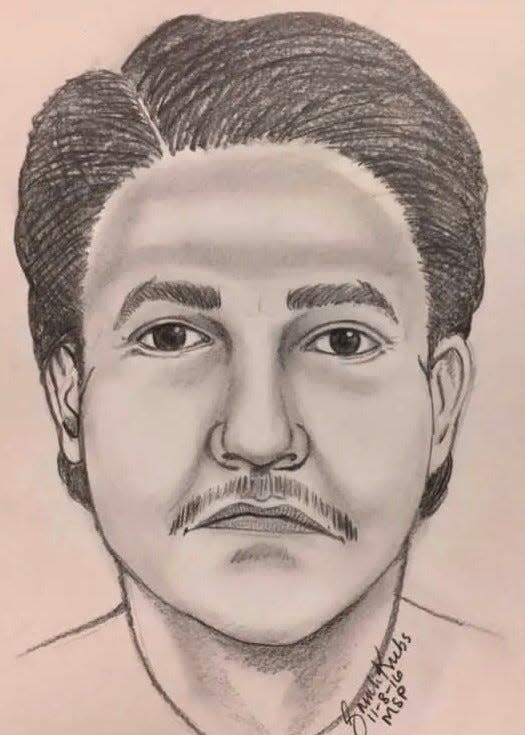Michigan police may be close to solving slaying of man whose head and hands were cut off
Authorities seem closer than ever to resolving two mysteries that have baffled them for a quarter-century: What is the identity of a man whose naked body was brutally mutilated, left handless and headless in a Blissfield Township cornfield? And who was the cold-blooded killer — or killers — who took his life?
Michigan State Police Detective Sgt. Larry Rothman said multiple officers and agencies have been working on the case for years, poring over forensic evidence and gathering information from anyone who might know something that could solve it.
What makes the case especially daunting, as Rothman put it, is it's "an investigation in an investigation."

Until recently, the gruesome homicide never garnered much media attention outside Lenawee County. This week, U.S marshals made two arrests, which made national headlines, and that, Rothman said, could be the key to cracking both cases.
"It's still early in the investigation, so there's not a whole lot I can say," the detective said, adding that if he did, it could jeopardize the results. "But, we feel these two guys knew the victim, they were acquaintances at one point."
The Daily Telegram in Adrian reported U.S. marshals picked up Richardo Sepulveda, 51, of Cincinnati, and Michael Sepulveda, 49, of Toledo, in Ohio on Tuesday, charging them in connection with what police believed was a drug homicide. They are charged with first-degree murder, a crime punishable by up to life in prison without parole.
In addition, the brothers face related charges: conspiracy to commit first-degree murder, assault with intent to maim, conspiracy to commit assault with intent to maim, tampering with evidence, and conspiracy to commit tampering with evidence.
And, by late Wednesday, Rothman said, he had received up to 20 calls about the case from reporters and tipsters.
Years of chasing leads
A farmer stumbled on the partially decomposing body on Nov. 19, 1997, in a field off Corey Highway. Police searched but did not find other remains. One theory suggested that the man was killed somewhere else and then dumped in the field.
And for years, Rothman said, police pursued leads, no matter how far-fetched they might have seemed. But, he said, each time the investigation got passed from one detective to another, it tended to lose significant momentum, and the investigator would have to start from the beginning.
"This case is really not unique when it comes to cold cases in general and how long it takes to solve them," Rothman said. "The detective who started investigating worked really hard on the case, and then the following year he got another homicide he had to investigate. And things kept piling up."
And without new leads, he said, investigations tend to stall.
Eventually, however, police used clues from witnesses and medical examiners to create a composite sketch of the victim: a light-skinned, 5-foot-8, 150-pound, white or Hispanic man between 20 and 40 years old who authorities suspect had come from southern Texas — McAllen or Weslaco, near the Mexican border — and may be named Roberto.
The victim is listed in the justice department's National Missing and Unidentified Persons System.
According to the system, 600,000 individuals go missing nationally each year, many are quickly found, alive and well. However, tens of thousands of people remain missing for more than one year, which many agencies consider cold cases. And about 4,400 dead bodies turn up a year, and some never are identified.
While the suspects had been in detectives' sights for almost 20 years, Rothman said, they have eluded arrest, in part because of the unidentified victim.
"It's kinda hard to try a homicide when you don't know who your victim is," he said.
Likely connected to drugs
Rothman, who has been investigating the victim's identity and seeking to bring the perpetrators to justice since 2016, said the man's missing head and hands make it difficult to identify the body.
A saw, reports said, likely was used, based on the marks on the victim's bones.
There were no tattoos or scars on the body, and the head and hands were never found.
Investigators are attempting to make a DNA match, but so far have been unsuccessful.
Still, authorities made the two arrests mostly because Michigan's attorney general felt there was enough evidence to prosecute the case.
"These guys have been on our radar, so to speak, since early on, based on dealings that they've had in the Toledo area with narcotics and drugs," Rothman said of the suspects. "That's how they are probably connected to our victim, through the drug trade."
Rothman said he is hopeful the Sepulveda brothers, who are being extradited from Ohio, will reveal the victim's identity to authorities. But, he added, even if they do not, renewed public attention likely will generate more tips and leads.
One of them, he said, came from a woman in the Upper Peninsula who recalled a slaying that followed a similar pattern. That could be helpful — or not. But, Rothman said, he would prefer to have more people call in tips, than less.
The state police, he said, want to make every effort they can to solve the case.
"Someone's potentially missing a dad. Someone's potentially missing a husband," he said. "There's somebody out there, and we believe that this person might be from Texas, and someone's missing their loved one and they have no clue where they went. They just know they left in 1997 — and never returned."
Contact Frank Witsil: 313-222-5022 or fwitsil@freepress.com.
Have a tip?
Authorities are asking anyone with information to call State Police Detective Sgt. Larry Rothmanat 313-407-9379.
This article originally appeared on Detroit Free Press: Police want to find identity, killer of man found in Blissfield Twp.
